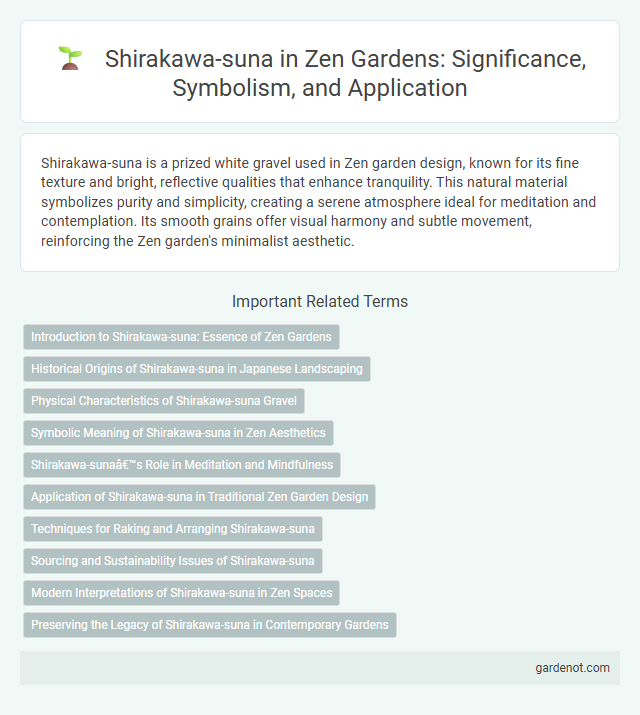Shirakawa-suna is a prized white gravel used in Zen garden design, known for its fine texture and bright, reflective qualities that enhance tranquility. This natural material symbolizes purity and simplicity, creating a serene atmosphere ideal for meditation and contemplation. Its smooth grains offer visual harmony and subtle movement, reinforcing the Zen garden's minimalist aesthetic.
Introduction to Shirakawa-suna: Essence of Zen Gardens
Shirakawa-suna, a unique type of sand from Japan's Shirakawa River, is essential in crafting authentic Zen gardens, prized for its natural texture and subtle coloration ranging from white to light gray. This sand embodies the Zen garden philosophy by symbolizing water and promoting meditation through its raked patterns and serene appearance. The mineral composition, including feldspar and mica, enhances its durability and aesthetic appeal, making Shirakawa-suna a fundamental element in traditional Japanese landscaping.
Historical Origins of Shirakawa-suna in Japanese Landscaping
Shirakawa-suna, a finely textured white sand sourced from the Shirakawa River in Kyoto, has been integral to Japanese landscaping since the Heian period (794-1185). This natural material was historically prized for its aesthetic purity and symbolic representation of water in Zen gardens, embodying tranquility and spiritual reflection. Its use reflects traditional Japanese principles of wabi-sabi, emphasizing simplicity and the beauty of imperfection in garden design.
Physical Characteristics of Shirakawa-suna Gravel
Shirakawa-suna gravel, sourced from the Shirakawa River in Kyoto, features angular, irregularly shaped particles that create a distinctive textured surface in Zen gardens. Its natural hues range from muted gray to soft beige with occasional flecks of white and black, providing subtle color variation that enhances visual depth. The gravel's coarse, sharp edges contrast with the smooth polished rocks often used in Japanese garden design, offering both aesthetic appeal and practical drainage benefits.
Symbolic Meaning of Shirakawa-suna in Zen Aesthetics
Shirakawa-suna, the white sand sourced from the Shirakawa River in Japan, embodies purity, simplicity, and spiritual clarity in Zen aesthetics. Its fine texture and bright color symbolize the impermanence of life and the quiet reflection essential to Zen meditation. This sacred sand serves as a visual metaphor for mindfulness and the harmonious balance between nature and human spirit in traditional Zen gardens.
Shirakawa-suna’s Role in Meditation and Mindfulness
Shirakawa-suna, characterized by its fine white and black grains, plays a crucial role in Zen garden meditation by promoting tranquility through its calming visual patterns. The texture of Shirakawa-suna enhances mindfulness by encouraging practitioners to focus on precision and intentionality while raking the sand, fostering a meditative state. Its unique mineral composition reflects light subtly, creating a serene atmosphere that aids concentration and deep reflection during mindfulness practices.
Application of Shirakawa-suna in Traditional Zen Garden Design
Shirakawa-suna, a distinctive white sand sourced from Japan's Shirakawa River, plays a crucial role in traditional Zen garden design by symbolizing purity and tranquility. Its fine texture and natural white color create a serene canvas that enhances the visual contrast with rocks and greenery, promoting meditation and mindfulness. The careful raking patterns formed in Shirakawa-suna represent waves or ripples, embodying impermanence and the harmonious flow of nature in Zen aesthetics.
Techniques for Raking and Arranging Shirakawa-suna
Shirakawa-suna, renowned for its fine texture and pale color, is carefully raked using wide, flat wooden tools to create precise, flowing patterns that evoke natural landscapes. Mastery of asymmetry and spacing enhances the visual depth, while deliberate, rhythmic strokes maintain consistency in wave and ripple motifs. Strategic placement of coarse and smooth grains intensifies contrast, emphasizing tranquility and harmony in traditional Japanese Zen gardens.
Sourcing and Sustainability Issues of Shirakawa-suna
Shirakawa-suna, sourced exclusively from the Shirakawa region in Japan, is prized for its unique texture and color essential to authentic Zen gardens. Sustainable quarrying practices are critical to preserve the delicate natural environment and maintain the quality of this rare gravel. Increased demand has raised concerns about over-extraction, prompting efforts to implement controlled sourcing and rehabilitation of quarry sites to ensure long-term availability.
Modern Interpretations of Shirakawa-suna in Zen Spaces
Modern interpretations of Shirakawa-suna in Zen spaces emphasize its unique granular texture and natural shades of white, gray, and beige, contrasting with traditional uniform white sands. Designers integrate Shirakawa-suna to evoke tranquility while introducing contemporary aesthetics through sculpted patterns and mixed materials. This approach enhances mindfulness and visual interest, bridging ancient Zen principles with modern minimalism and ecological awareness.
Preserving the Legacy of Shirakawa-suna in Contemporary Gardens
Shirakawa-suna, known for its distinct white and gray hues, plays a crucial role in preserving the aesthetic and spiritual essence of traditional Japanese Zen gardens. Carefully sourced from the Shirakawa River in Kyoto, this sand maintains its unique texture and color, symbolizing purity and tranquility in contemporary garden designs. Integrating authentic Shirakawa-suna ensures the continuation of Zen garden heritage while enhancing modern landscapes with its serene and meditative qualities.
Shirakawa-suna Infographic

 gardenot.com
gardenot.com